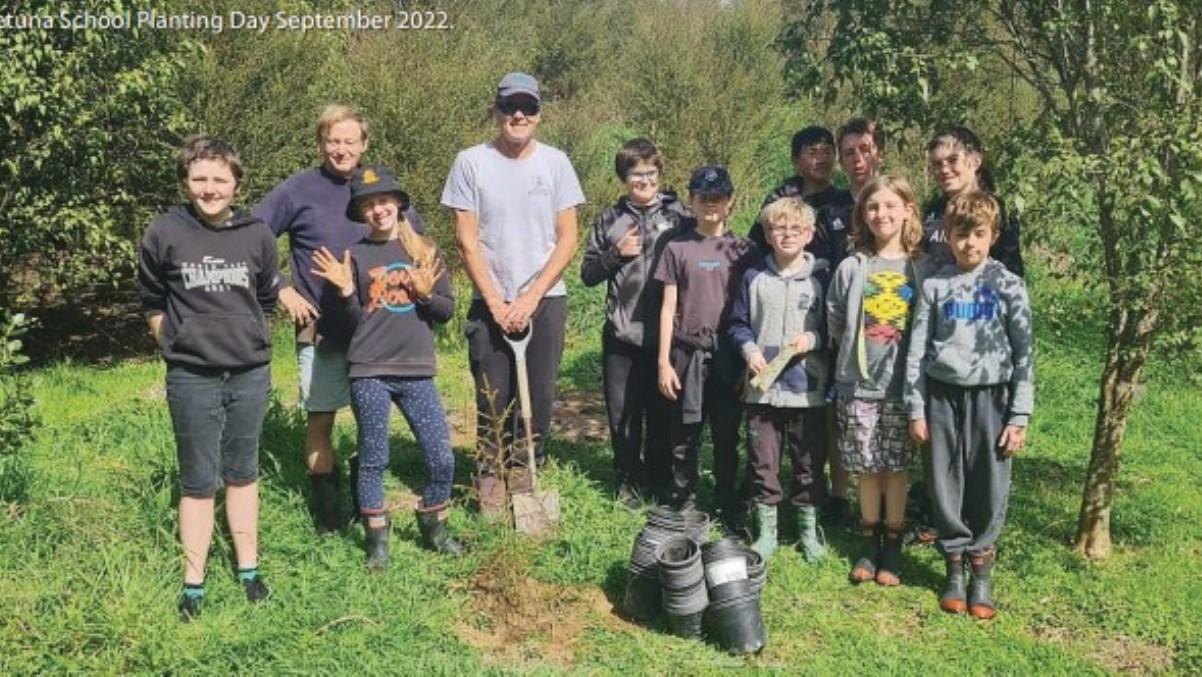Republished from Canopy Autumn 2023, Native Forest Restoration Trust
by Bill Carlson, Honorary Ranger, Ed Hillary Hope Reserve
Community tree planting has become a young tradition at Ed Hillary Hope, with the first held just weeks after the official opening of the reserve in May 2015. This event brought plenty of interest, with a diversity of participants including locals interested in the new reserve, Waikato Forest and Bird members, Kiwi Conservation Club families and NFRT stalwarts from far and wide. The community planting area of about 4 hectares, or less than 1% of the total reserve area of 466 hectares, is a high impact site. It is adjacent to the reserve entrance and carpark, with frontage along Old Mountain Road, so is very accessible and visible. The beautiful Mangakiriri Stream runs along the boundary of the area and across the stream is the edge of some 200 hectares of remnant forest. However, it is also a planting site with challenges. The history of grazed pasture in the relatively wet area had left a dense mat of creeping buttercup which is very difficult for young plants to establish in. The site is also a frost pocket, cold air from three valleys drains into the area. This limits our range of species to plant. Just 50 metres away and up the hill out of the frost, rewarewa is a regeneration success, growing from seed in old pasture. But we have learned from experience that it’s not worth planting rewarewa or other tender species in our ‘frosty’ area. From 2016 to 2020 community plantings continued with a diverse range of participants, some new recruits every year, and many seasoned planting veterans, with reserve manager Sharen Graham and trustee Dell Hood at the helm. Working steadily across the area planting mainly colonising species: kanuka, mahoe, coprosma species, wineberry and lacebark. Plants are sourced from the Waikato Ecological Restoration Trust (WERT) nursery, specially grown for us from seed sourced in the reserve. Some plants have struggled: competition from weeds, a persistent goat problem and three very dry summers have taken their toll. Coprosma robusta has lived up to its name, and kanuka has established well although slower to rise above the weeds.
Plans for the 2021 planting season were modest, with only 200 plants on order. These included kahikatea and lacebark; ‘proper’ forest trees for planting in the wetter areas and where the recent plantings and existing remnant trees provided shelter and breaks in the dense cover of buttercup. Planting plans had to
be put on hold in August when all of New Zealand returned to COVID-19 Level 4 restrictions. Level 3 restrictions remained off and on in the Waikato until October. Fortunately, we had picked up the trees from the nursery in late July and had prepared our sites by spot spraying, so we were ready to go at any time.

Jon Thompson, a Waitetuna local and keen Hillary Hope volunteer, helps at our local Waitetuna School one day per week teaching the kids gardening and plant propagation skills. Jon and the kids have been collecting native seed and seedlings growing on the tracks in the reserve, potting them and growing
them on in the nursery at the school. The plan had always been that these would be planted by the kids in the reserve, giving them the experience of growing trees from seed and watching them grow into a new forest. In 2021 the children had their first batch of trees, 20 tanekaha, 20 nikau and 60 cabbage trees ready for planting!
Covid held things up but at long last, after restrictions were eased and the kids returned from school holidays, we had our planting day on 21 September 2021. On a fine day, with about 20 schoolchildren, teachers and parent helpers the planting was completed just in time for lunch at the big picnic table.
For the 2022 planting we were only able to order 100 kahikatea trees from the WERT nursery. But on arrival at the nursery to pick them up, the indefatigable nursery manager Jan Simmons dug deep, and we returned to Waitetuna with a full trailer of 250 trees, mostly kahikatea and kanuka, perfect for our site. These were planted by the Waitetuna School kids on 25 August, again finishing the work in time for lunch.
On 16 September our school kids returned and we soon had the 70 trees planted. The special rimu and puketea were carefully placed in sheltered places among the few large remnant kahikatea and young, well grown trees that had been planted in earlier plantings, now three to four metres high. We planted some of the rewarewa higher up the slopes, rashly thinking they would surely be out of frost’s reach until next winter when as established trees they would survive.
The usually reliable Waikato weather gave us a nasty surprise on 7 October 2022 with a monumental frost which burnt off some of those rewarewa, but otherwise the new plantings have fared well. The mild, wet weather we have experienced since has given rampant growth, both in our planted trees and in the weeds around the area. The new plantings have been release-sprayed, and we have begun a programme of spraying the bindweed with the herbicide Banvine. We will see how that works and if the results are promising we may have the courage to begin future plantings in the heavily infested areas over the
stream along the Old Mountain Road frontage. Otherwise, future community plantings will continue to fill in the gaps in our planted area, best with our hardy pioneer species kanuka and karamu. A casual observation is that the buttercup mat is opening up and slowly giving way to a host of other weed species, among them stone parsley, wild teasel and Stachys sylvatica. Whether this is a favourable change for young trees is yet to be seen, it is certainly very untidy!

